

Kolade Chris
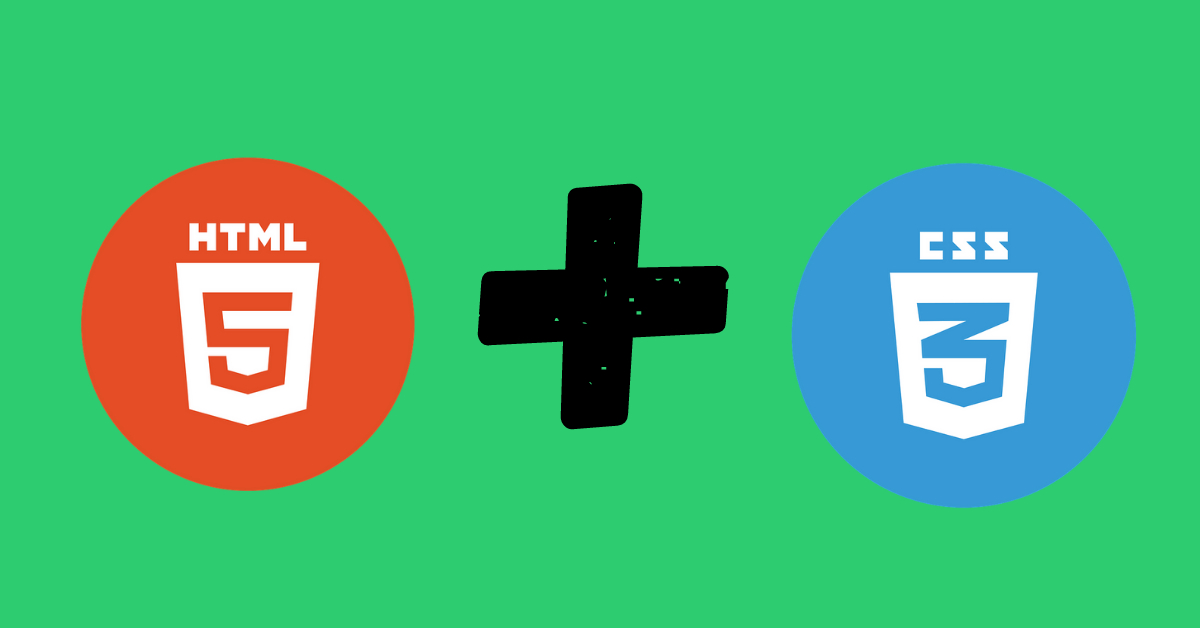
When you're learning about web development, you probably hear about HTML and CSS pretty quickly. Well, what are these tools and how do you use them?
You can think of HTML as the structure and framing of a house. And when you want to make that structure look good, you add paint, decor, and other features. This decoration is the CSS.
HTML stands for hypertext markup language. It is a text-based document designed to be displayed in a browser. To make that texts and other embedded elements contained in the HTML look good, you need to add CSS, or Cascading Style Sheets.
There are 3 different ways you can style your HTML:
In this tutorial, we'll explore these three styling methods in as much depth as possible. We'll also look at their pros and cons so you can start using them in your coding projects and choose which one works best for you.
To make things easier in this tutorial, I have prepared a simple HTML template that we'll style:
article> p class="paragraph-one"> freeCodeCamp is one of the best platforms to learn how to code p> p class="paragraph-two"> Learning to code is free on freeCodeCamp, that's why they call it freeCodeCamp p> p class="paragraph-three"> freeCodeCamp generates money through donations inorder to pay employees and maintain servers. p> p id="paragraph-four"> If you're generous enough, consider joining others who have been donating to freeCodeCamp p> p class="paragraph-five"> At freeCodeCamp, it's not all about typing on a code editor alone, there's a forum like StackOverflow, where you can ask questions about your coding problems and get answers from campers alike. p> article> 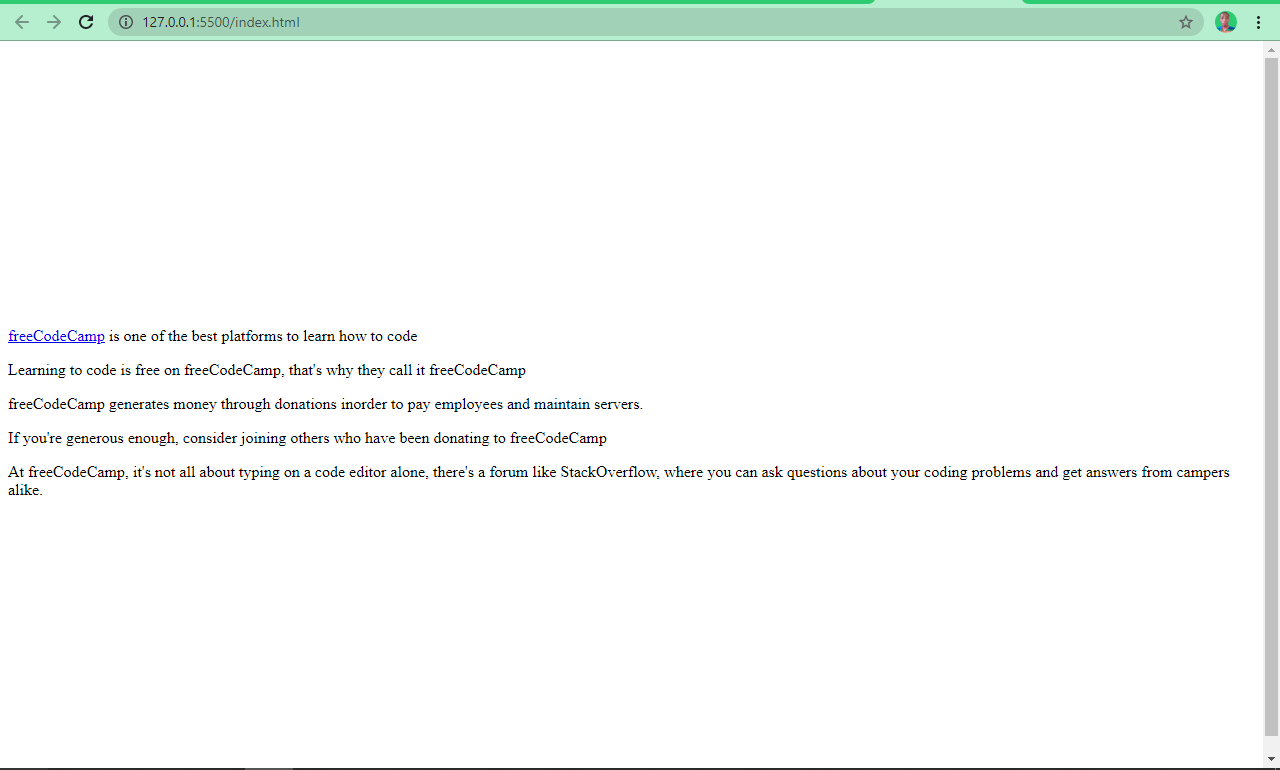
When you use inline styles, you add them directly to the HTML tags with the style attribute.
For example, in our HTML code, we can assign a color to any of the paragraphs by writing the CSS right inside the opening tag.
It is also typical to remove the default underline and color assigned to links, so we can do that inside the opening tag too.
article> p class="paragraph-one" style="color: darkmagenta; font-size: 2rem; text-align: center" > a href="freecodecamp.org" style="text-decoration: none; color: crimson" >freeCodeCamp a > is one of the best platforms to learn how to code p> p class="paragraph-two"> Learning to code is free on freeCodeCamp, that's why they call it freeCodeCamp p> p class="paragraph-three"> freeCodeCamp generates money through donations inorder to pay employees and maintain servers. p> p id="paragraph-four"> If you're generous enough, consider joining others who have been donating to freeCodeCamp p> p class="paragraph-five"> At freeCodeCamp, it's not all about typing on a code editor alone, there's a forum like StackOverflow, where you can ask questions about your coding problems and get answers from campers alike. p> article> Can you see that the first paragraph is now less readable? That's one of the downsides of using inline styles, which we'll see below.
Our web page now looks like the screenshot below:
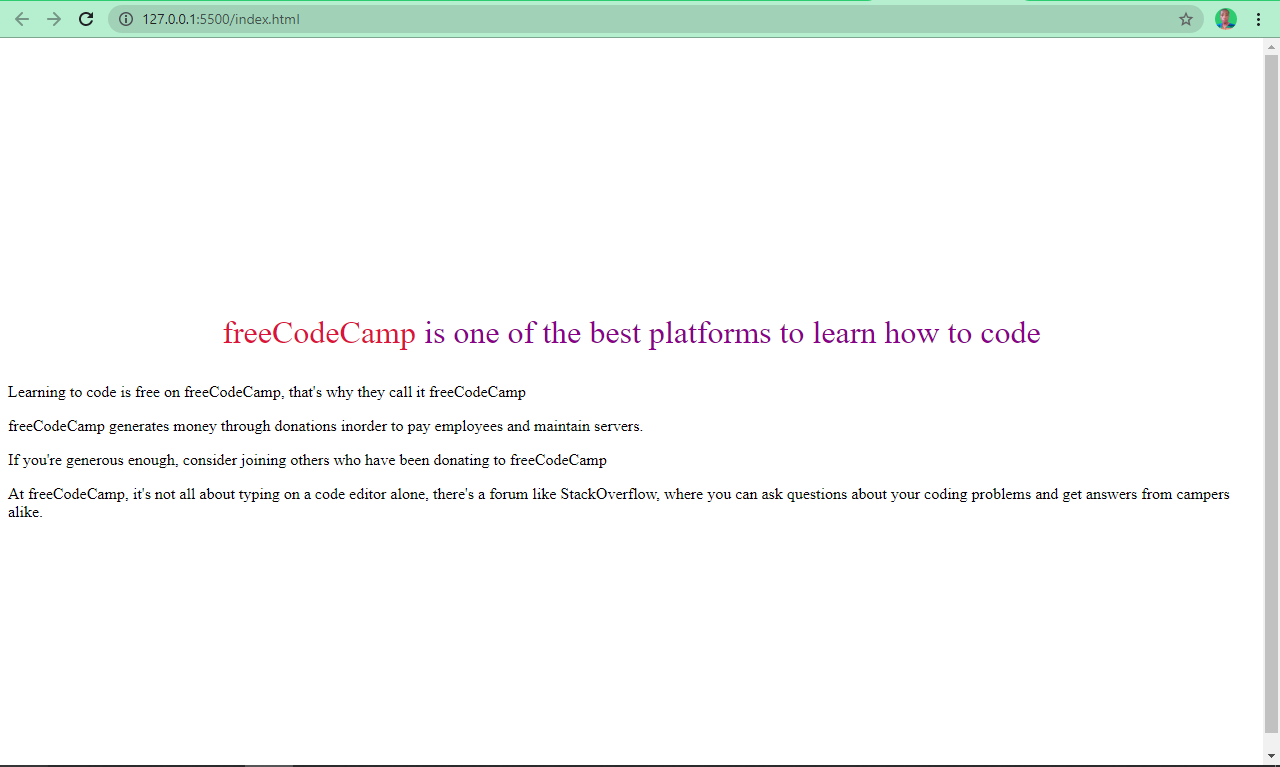
When you use internal styling, you embed the styles right inside the HTML file within the style tag. You usually place them in the head, but it works anywhere, even outside of the opening and closing HTML tags (but don't do that as it's a bad practice).
We can apply some internal styles to our HTML code like this:
style> * < padding: 0; margin: 0; box-sizing: border-box; > body < display: flex; align-items: center; justify-content: center; height: 100vh; > .paragraph-two < font-size: 1.5rem; > .paragraph-one a < text-decoration: none; color: crimson; font-size: 2rem; font-weight: bolder; > style> head> body> article> p class="paragraph-one"> a href="freecodecamp.org">freeCodeCamp a> is one of the best platforms to learn how to code p> p class="paragraph-two"> Learning to code is free on freeCodeCamp, that's why they call it freeCodeCamp p> p class="paragraph-three"> freeCodeCamp generates money through donations inorder to pay employees and maintain servers. p> p id="paragraph-four"> If you're generous enough, consider joining others who have been donating to freeCodeCamp p> p class="paragraph-five"> At freeCodeCamp, it's not all about typing on a code editor alone, there's a forum like StackOverflow, where you can ask questions about your coding problems and get answers from campers alike. p> article> You can see that we now have more styling options when we use internal styles.
If you are wondering what combinators are, they are the symbols used to connect different selectors. An example is a space ( `) for selecting the next descendant of an element, such as any paragraph ( p ) that comes after a div`.
Class selectors are denoted by a dot ( . ), and id selectors are denoted by a # .
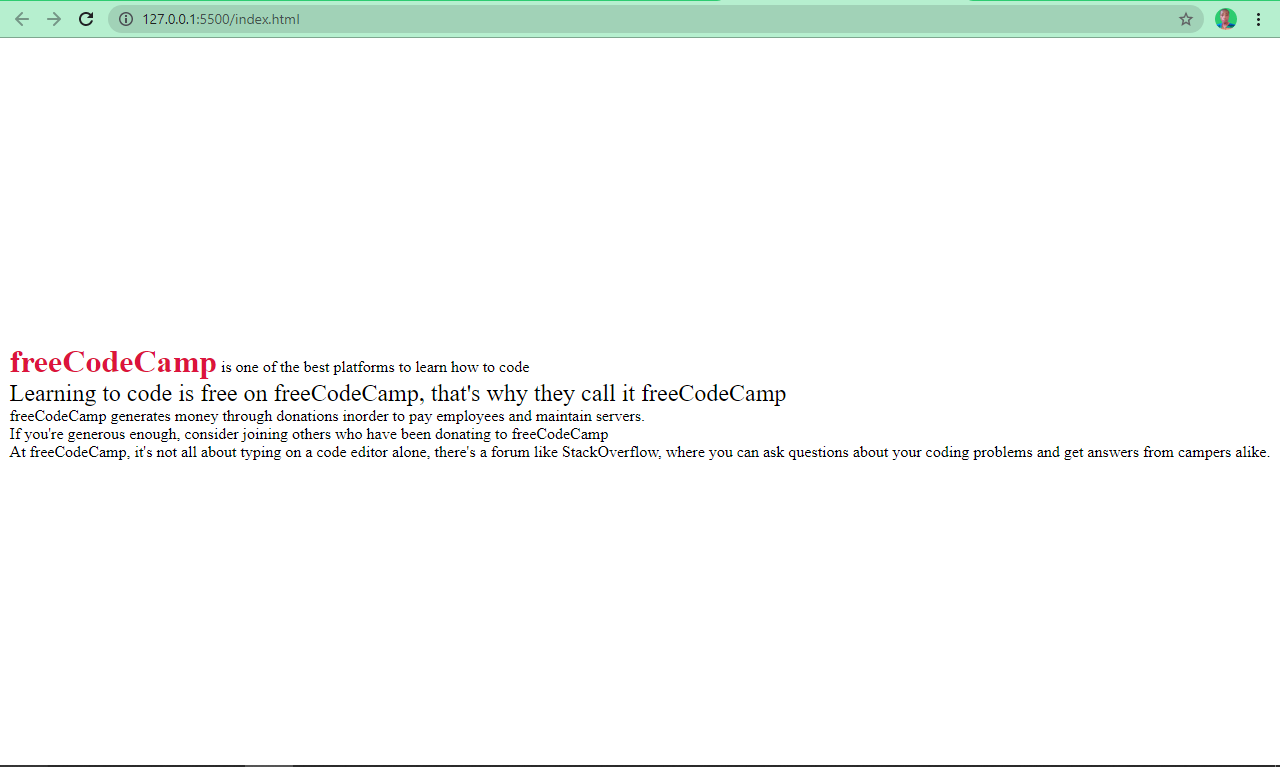
Our web page now looks like this:
This is considered the best way to style your HTML code. External stylesheets are totally separate from the HTML and you place them in a CSS file (with the .css extension).
To use external stylesheets in your HTML, you link them within the head with the link tag.
The basic syntax of the link tag looks like this:
link rel="stylesheet" href="path-to-css-file"> To style our HTML code, we need to create a CSS file and link it. When linked, our full HTML file now looks like this:
html> html lang="en"> head> meta charset="UTF-8" /> meta http-equiv="X-UA-Compatible" content="IE=edge" /> meta name="viewport" content="width=device-width, initial-scale=1.0" /> title>How to Style HTML title> link rel="stylesheet" href="styles.css" /> head> body> article> p class="paragraph-one"> a href="freecodecamp.org">freeCodeCamp a> is one of the best platforms to learn how to code p> p class="paragraph-two"> Learning to code is free on freeCodeCamp, that's why they call it freeCodeCamp p> p class="paragraph-three"> freeCodeCamp generates money through donations inorder to pay employees and maintain servers. p> p id="paragraph-four"> If you're generous enough, consider joining others who have been donating to freeCodeCamp p> p class="paragraph-five"> At freeCodeCamp, it's not all about typing on a code editor alone, there's a forum like StackOverflow, where you can ask questions about your coding problems and get answers from campers alike. p> article> body> html> You might be wondering why the path to the CSS file is just style.css , which is also the filename. This is because the HTML and CSS files are in the same directory. If you have the stylesheet in another folder, you have to include the folder name before the filename.
Let's apply some stylings to our HTML in our external stylesheet:
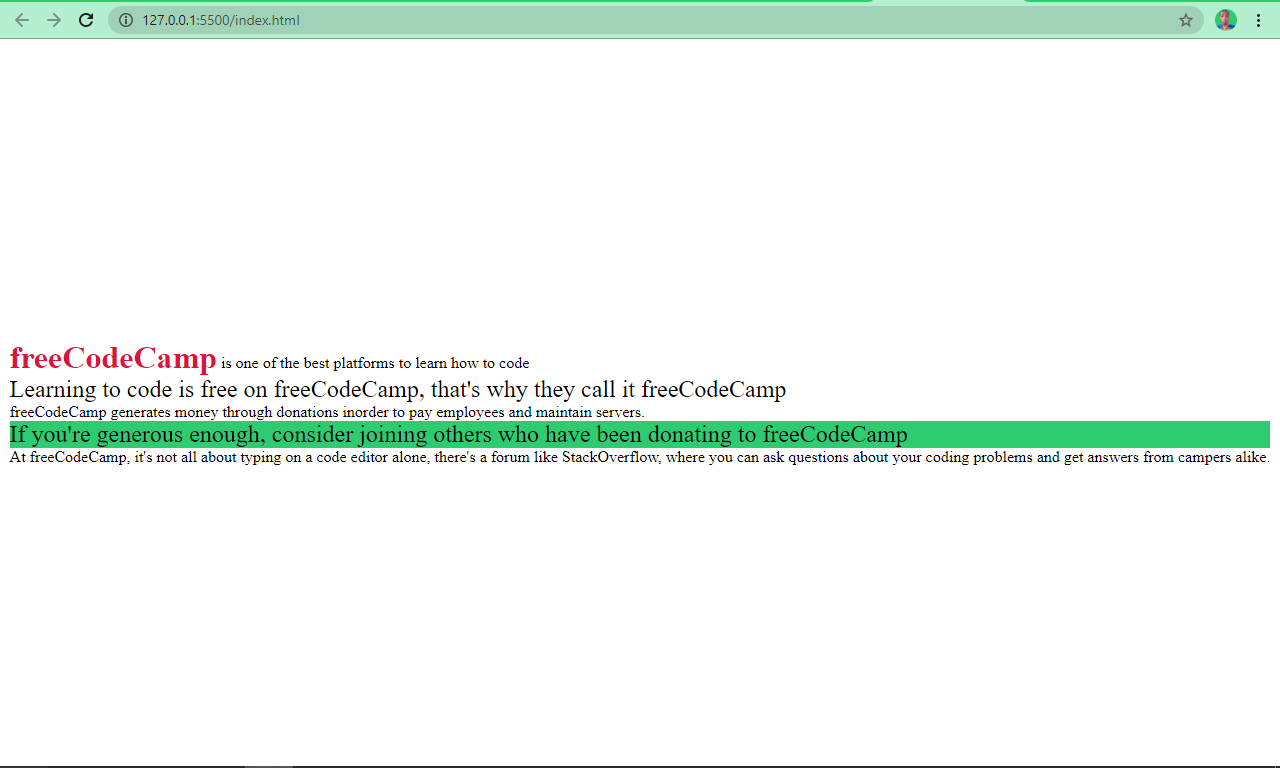
I hope this tutorial has helped you learn the various ways you can style your HTML.
And now you also know the pros and cons of each method, so you can pick the one that is best for you.
Thanks for reading, and keep coding.